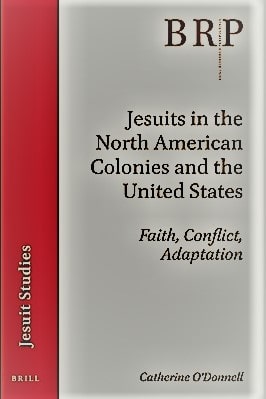
| Book Title | Jesuits In The North American Colonies And The United States |
| Book Author | Catherine O’Donnell |
| Total Pages | 118 |
| Book Views | |
| Language | English |
| Book Download | PDF Direct Download Link |
| Get Hardcover | Click for Hard Similar Copy from Amazon |
Jesuits in the North American – Colonies and the United States Faith, Conflict, Adaptation
By Catherine O’Donnell
JESUITS IN THE NORTH AMERICAN – COLONIES AND THE UNITED STATES FAITH, CONFLICT, ADAPTATION
From Eusebio Kino to Daniel Berrigan, and from colonial New England to contemporary Seattle, Jesuits have built and disrupted institutions in ways that have fundamentally shaped the Catholic Church and American society.
As Catherine O’Donnell demonstrates, Jesuits in French, Spanish, and British colonies were both evangelists and agents of empire.
John Carroll envisioned an American church integrated with Protestant neighbours during the early years of the republic; nineteenth-century Jesuits, many of them immigrants, rejected Carroll’s ethos and created a distinct Catholic infrastructure of schools, colleges, and allegiances.
The twentieth century involved Jesuits first in American war efforts and papal critiques of modernity, and then (in accord with the leadership of John Courtney Murray and Pedro Arrupe) in a rethinking of their relationship to modernity, to other faiths, and to earthly injustice.
O’Donnell’s narrative concludes with a brief discussion of Jesuits’ declining numbers, as well as their response to their slaveholding past and involvement in clerical sexual abuse.
Members of the Society of Jesus first set foot on land that would become part of the United States in the earliest days of European colonization.
In the years that followed, Jesuits explored territory, proselytized indigenous peoples, and participated in Spanish, French, and English imperialism in ways that shaped both local and transatlantic communities.
In the eighteenth century, the order ran afoul of European sovereigns. After first facing banishment from particular realms, in 1773 the Society was suppressed by Pope Clement XIV (1705–74, r.1769–74).
Yet, Jesuits remained a part of the history of the American church even when they did not, in the view of the church, exist.
The Jesuit who would become the first bishop and archbishop in the United States, John Carroll (1735–1815), drew on his formation in the Society and on his brethren’s advice as he knit Catholicism into the revolutionary and early national United States. And although only a handful of former Jesuits remained when the order was restored, their numbers and influence grew rapidly.
Within twenty years, Jesuits confidently participated in arguments over the role of Catholics and of religion itself in the United States, and they began to create an educational network that stretched the length and breadth of the nation.
Throughout much of the nineteenth century, members of the restored Society saw themselves as defenders of tradition and orthodoxy against the “corrosions” of modernity, repudiating the pragmatic accommodations that had often characterized Jesuits’ work throughout the globe.
In the twentieth century, Jesuits again began to collaborate with a range of cultural, political, and religious actors as they worked to extend the reach of the church as they understood it. The Second World War, the postwar era, and the Second Vatican Council (1962–65) brought dramatic transformation. Some Jesuits embraced the changes and remade the order from within.
Many others left. Their departure and the declining number of young men beginning Jesuit formation means that Jesuits have needed in recent years once again to rethink their role in the world and the nature of their community.
Across the centuries, American Jesuits have been a small group—some eight thousand members at their peak, usually far fewer—and one mistrusted by many of their countrymen.
Yet, American history is incomplete without attention to their labours. Jesuits, for their part, cannot be understood without exploration of the imperial, national, and cultural histories in which they have participated as individuals and as an order.
To read more about the Jesuits In The North American Colonies And The United States book Click the download button below to get it for free
Report broken link
Support this Website
Click here to join our Telegram group for new Books